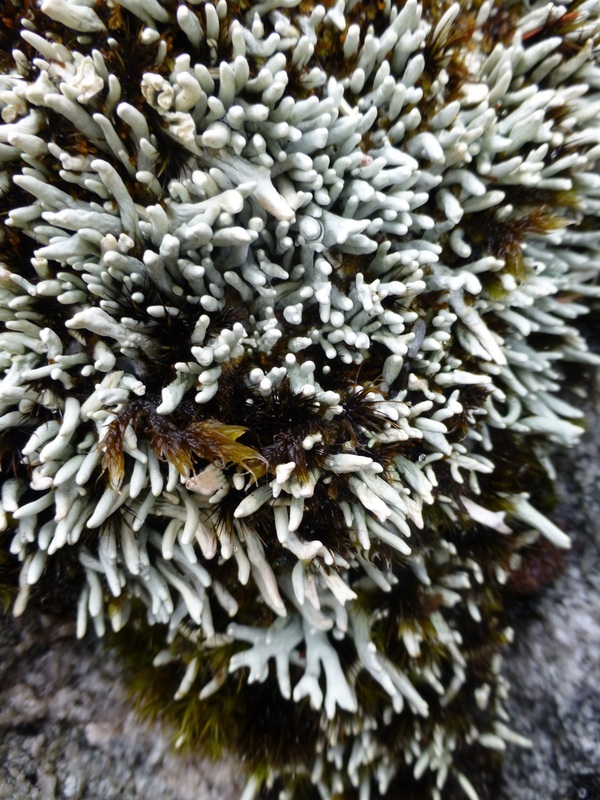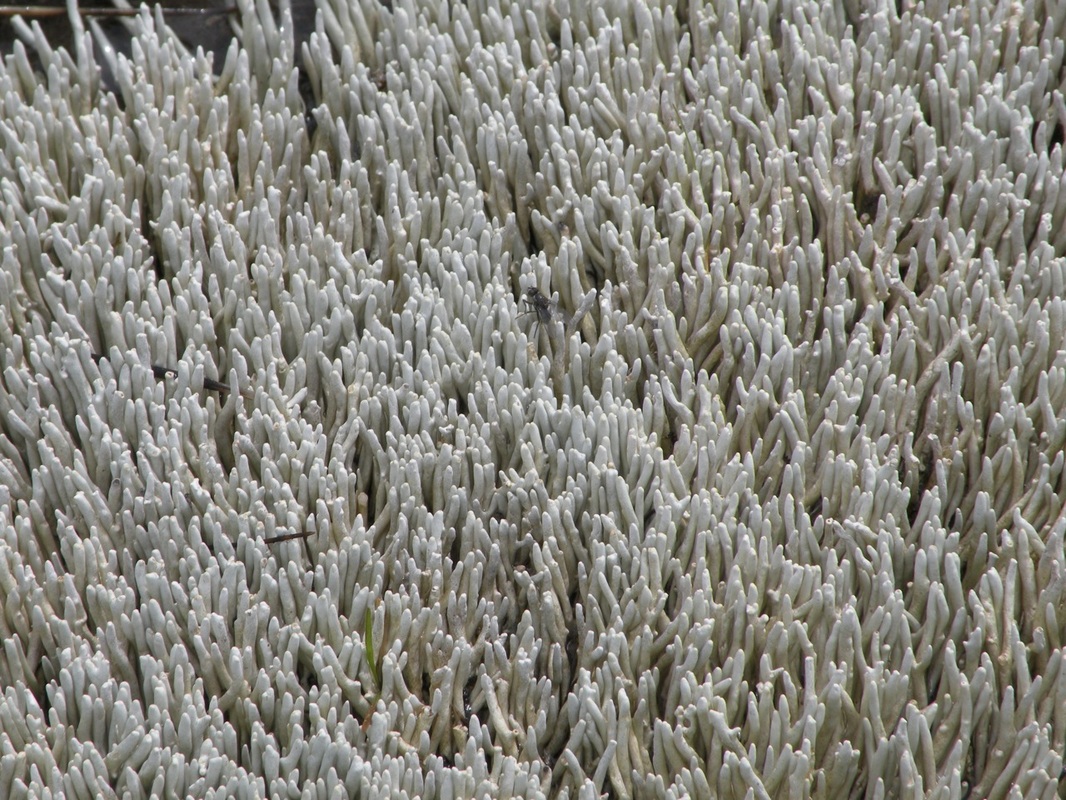Waterworm, arctic fingerbones • Siphula ceratites
{Siphula = small tube; ceratites = horn-like}

Waterworm on Calvert Island. Photos by Ian Cruikshank (left) and Kira Hoffman.
|
Identification
Waterworm is an upright club lichen that grows in fairly dense clusters. It reaches 3 cm tall, is white and solid with blunt tips and longitudinal furrows. It does not bear fruiting bodies.
Habitat & Range
Waterworm tends to grow in wet soils or in standing water in peatlands. It is found in low to middle elevations from the Central Coast of BC north to Alaska and the Aleutian Islands. It has a circumpolar distribution and mainly grows in humid, coastal areas. In some areas of its distribution it is found in montane and alpine habitats, including alpine tundra.
Similar Species
Thamnolia vermicularis is a similar club lichen that has hollow rather than solid clubs. In BC it is restricted to exposed areas and is usually found above the treeline.
Intriguing Info
Most lichens need to be wetted and dried at fairly regular intervals; waterworm is an exception as it can soak in standing water for months at a time.
iNaturalist
https://www.inaturalist.org/taxa/231063-Siphula-ceratites
Waterworm is an upright club lichen that grows in fairly dense clusters. It reaches 3 cm tall, is white and solid with blunt tips and longitudinal furrows. It does not bear fruiting bodies.
Habitat & Range
Waterworm tends to grow in wet soils or in standing water in peatlands. It is found in low to middle elevations from the Central Coast of BC north to Alaska and the Aleutian Islands. It has a circumpolar distribution and mainly grows in humid, coastal areas. In some areas of its distribution it is found in montane and alpine habitats, including alpine tundra.
Similar Species
Thamnolia vermicularis is a similar club lichen that has hollow rather than solid clubs. In BC it is restricted to exposed areas and is usually found above the treeline.
Intriguing Info
Most lichens need to be wetted and dried at fairly regular intervals; waterworm is an exception as it can soak in standing water for months at a time.
iNaturalist
https://www.inaturalist.org/taxa/231063-Siphula-ceratites
References
Klinka, K., Krajina, V.M., Ceska, A., and Scagel, A.M. (1989). Indicator Plants of Coastal British Columbia. Vancouver, BC: University of British Columbia Press. P. 218.
McVean, D.N. (1956). An Arctic Lichen, Siphula ceratites, in Scotland. Nature. 177, 797 - 798.
Pojar, J. and MacKinnon, A. (1994). Plants of Coastal British Columbia. Vancouver, BC: Lone Pine Publishing. P. 500.
Siphula ceratites (Wahlenb.) Fr. In Klinkenberg, Brian. (Ed.). E-Flora BC: Electronic Atlas of the Plants of British Columbia. Lab for Advanced Spatial Analysis, Department of Geography, University of British Columbia, Vancouver. Accessed 25/04/2014.
Authors and editors of page
Kelly Fretwell and Brian Starzomski (2014).
Klinka, K., Krajina, V.M., Ceska, A., and Scagel, A.M. (1989). Indicator Plants of Coastal British Columbia. Vancouver, BC: University of British Columbia Press. P. 218.
McVean, D.N. (1956). An Arctic Lichen, Siphula ceratites, in Scotland. Nature. 177, 797 - 798.
Pojar, J. and MacKinnon, A. (1994). Plants of Coastal British Columbia. Vancouver, BC: Lone Pine Publishing. P. 500.
Siphula ceratites (Wahlenb.) Fr. In Klinkenberg, Brian. (Ed.). E-Flora BC: Electronic Atlas of the Plants of British Columbia. Lab for Advanced Spatial Analysis, Department of Geography, University of British Columbia, Vancouver. Accessed 25/04/2014.
Authors and editors of page
Kelly Fretwell and Brian Starzomski (2014).





